Not every artist attains the kind of status that will allow their early works to be revived – or, when revived, greeted with commercial and critical success. This is something of a shame for those of us with a historical mindset who like seeing where an artist has come from and how they have developed. Of course, some things are best left in a box under the bed with your teenage diaries, but Early Adventures, a tight selection of Matthew Bourne works from 1989-1991 which opened last night at Sadler's Wells, is not one of them.
The Infernal Galop and Town & Country, both shown in the last incarnation of the Early Adventures show, are joined this time by Watch With Mother (1991) which has not been seen since the early 90s. Fans of Bourne in his campy, naughty mode might miss Spitfire, the underwear advert sketch that Watch With Mother replaces, but there is still ample larking about in the other two pieces, and Watch With Mother brings a welcome emotional depth to an evening otherwise almost exhaustingly light-hearted.
Bourne combines emotional heft with theatrical flair
The conceit is simple: just schoolchildren playing, but Bourne has turned his usual perceptive eye on the intricacies of playground relationships. Constantly moving around, the nine dancers form and re-form into groups of two, three or four, interacting through a sharply observed physical language: girls crooning together with their arms round each others' waists, boys hulking and showing off, and a madcap finale that captures the whirlwhind energy of children, leaping and jackknifing through the air. Through it all there is a boy on the sidelines, whose lonely misery finds expression in a tragicomic, contorted solo that shows all Bourne's talent for combining emotional heft with theatrical flair. Tall, slender Paris Fitzpatrick, not much more than a child himself – he was on TV just two years ago as one of the finalists in the BBC Young Dancer ballet category – plays the outcast boy with aching poignancy. The character foreshadows the unfairly victimised innocents Bourne would go on to create (Edward Scissorhands, Angelo in The Car Man), and Fitzpatrick's haunting dance-acting suggests he might well go on to dance these roles himself. Exciting prospect.
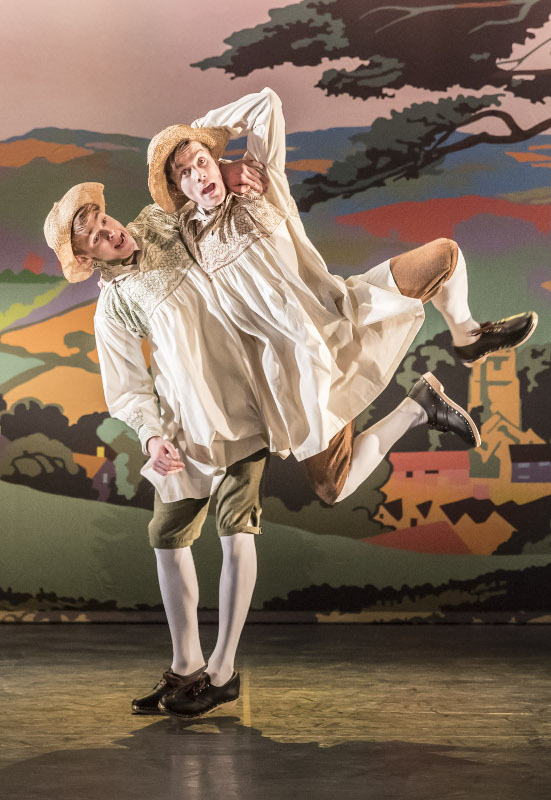 Fitzpatrick gets a prominent role in Town, too, playing one half of a courting gay couple with all the youthful hauteur and lip-trembling sensitivity of Kurt from Glee. This courtship is enacted across and in the background of several other vignettes, a smart little comment on closeted life in the first half of last century, but also early evidence of Bourne's signature ability to have multiple layers of story unfolding in the same space: again and again in his later works, something significant will happen at one side of the stage while half the cast are doing a big razzmatazz number on the other. There are a couple of such splendid numbers in Town: the Brief Encounter one is funny, yes, but for dance quality it is trumped by the unsurpassable bathing duet (main picture), in which exquisitely balletic Mari Kamata (Rambert training showing through) and swaggeringly masculine João Carolino prance about behind towels held by long-suffering servants.
Fitzpatrick gets a prominent role in Town, too, playing one half of a courting gay couple with all the youthful hauteur and lip-trembling sensitivity of Kurt from Glee. This courtship is enacted across and in the background of several other vignettes, a smart little comment on closeted life in the first half of last century, but also early evidence of Bourne's signature ability to have multiple layers of story unfolding in the same space: again and again in his later works, something significant will happen at one side of the stage while half the cast are doing a big razzmatazz number on the other. There are a couple of such splendid numbers in Town: the Brief Encounter one is funny, yes, but for dance quality it is trumped by the unsurpassable bathing duet (main picture), in which exquisitely balletic Mari Kamata (Rambert training showing through) and swaggeringly masculine João Carolino prance about behind towels held by long-suffering servants.
Sheer joie de vivre is supplied by a final number on scooters – one of many set-pieces, incidentally, that would make this piece a splendid one for children. Town's pendant piece, Country, is imbued with childlike humour too, including a pricelessly funny incident with a hedgehog that is all the better for being entirely unsophisticated. Anyone who has seen La Fille Mal Gardée will recognise in Country Bourne's affectionate homage to Frederick Ashton, with peasant smocks, mock carriage-driving and, of course, a clog dance – hilariously performed by Daniel Collins, with arms windmilling and face working like the young Hugh Laurie in Blackadder (pictured above left, Collins - on the right - with Paris Fitzpatrick). The piece points up Bourne's choreographic debt to Ashton, too: Sir Fred knew how to make great dance without forgetting the showbiz imperative to entertain, and his knack for translating everyday gestures and natural movements into formally complete dance steps is one Bourne likewise possesses in spades.
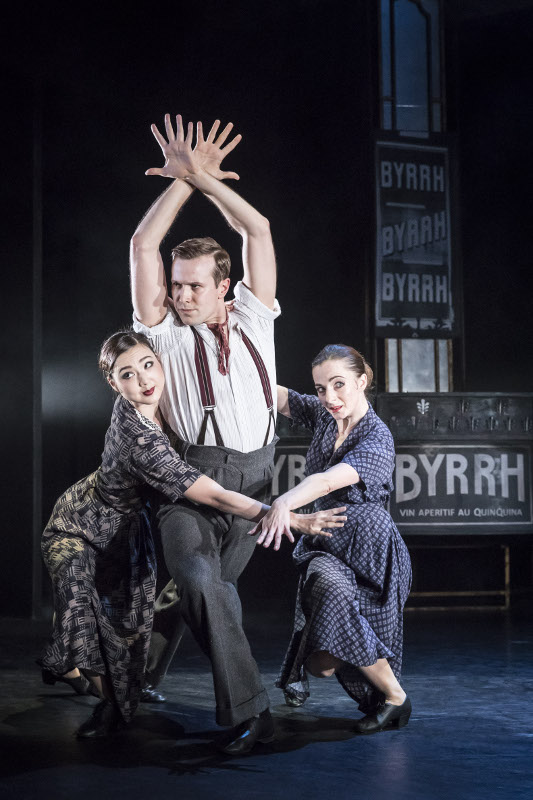 Depending on the degree of toilet humour they are prepared to tolerate/encourage, parents might want to skip the last piece, The Infernal Galop, which features a rather puerile sequence in a pissoir. As this implies, the piece relies for comic effect on sending up a certain British stereotype of Frenchness, dominated by black berets, Gauloises, matelot shirts, and extravagantly rolled R's (see also Kenneth Williams's "Ma Crêpe Suzette"). Some of it is exuberantly enjoyable – the merman in sock-suspenders undulating girlishly on a moonlit Côte d'Azur, the overblown double pas de deux to Edith Piaf (pictured right)– but unalloyed whimsy, so delicious as an amuse-bouche, begins to pall after three courses: I was ready to call "whoa" on The Infernal Galop some time before the end.
Depending on the degree of toilet humour they are prepared to tolerate/encourage, parents might want to skip the last piece, The Infernal Galop, which features a rather puerile sequence in a pissoir. As this implies, the piece relies for comic effect on sending up a certain British stereotype of Frenchness, dominated by black berets, Gauloises, matelot shirts, and extravagantly rolled R's (see also Kenneth Williams's "Ma Crêpe Suzette"). Some of it is exuberantly enjoyable – the merman in sock-suspenders undulating girlishly on a moonlit Côte d'Azur, the overblown double pas de deux to Edith Piaf (pictured right)– but unalloyed whimsy, so delicious as an amuse-bouche, begins to pall after three courses: I was ready to call "whoa" on The Infernal Galop some time before the end.
The early Bourne was a dancemaker of huge talent, charm and energy, but the later Bourne developed dramatic depths that – except in Watch With Mother – are not even hinted at in this light confection of an evening. He was good then, but he's even better now.
- Matthew Bourne's Early Adventures at Sadler's Wells to 8 April. The national tour concludes in Northampton on 12 April.
- Read more dance reviews on theartsdesk

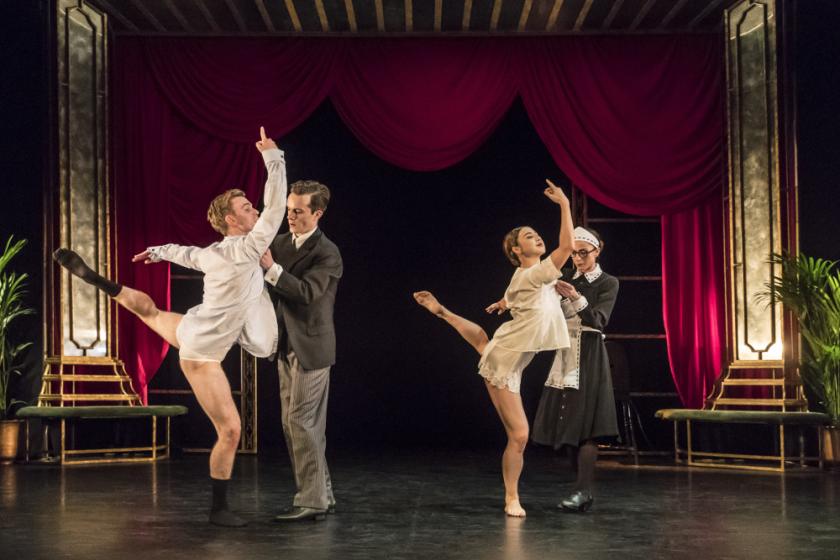

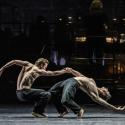
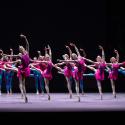
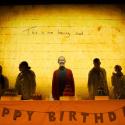
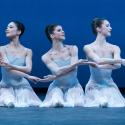
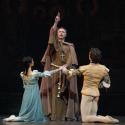
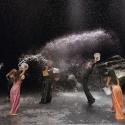
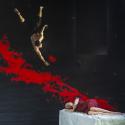
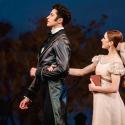
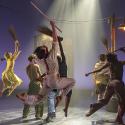
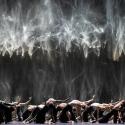
Add comment